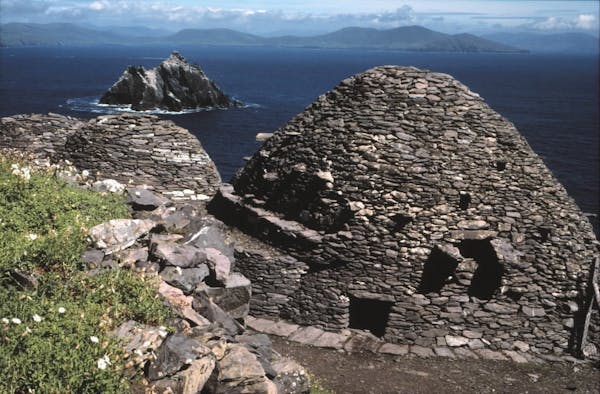How many islands dot Ireland's Clew Bay? As many as days of the year, goes the saying.
Scanning the green mounds peppering the white-capped sea below while visiting last summer, I tried futilely to distinguish from the other islands the grassy knoll where my grandmother was born.
They all looked the same from my vantage halfway up Croagh Patrick, the mountain that overlooks the bay, so after a swig of water and a few lungfuls of air, my husband and I continued our trek to the peak.
The mountain — referred to locally as the Reek — rises to about 2,500 feet above sea level and is 5 miles outside the seaside village of Westport in County Mayo. It draws about 100,000 people to the area each year.
Visitors at the start of the climb are greeted by a white statue of St. Patrick, the nation's patron saint and the mountain's namesake. At its summit is a small chapel where masses are celebrated on Reek Sunday, the last Sunday each July, when thousands turn out to walk together to the top. Some take the rocky trail barefoot.
We set off for the summit on a clear morning in June, with light jackets zipped over stomachs filled to bursting by the breakfast cooked to order by the proprietor of Plougastel House, the cozy bed and breakfast where we were staying in Westport.
Heading out, I remembered the first time I had hiked Croagh Patrick as a teenager, more than a decade ago: My memory was of my family and me bounding upward under a warming sun.
But on this climb, about halfway up the mountain the crowd began to thin as the temperature dropped and fog dampened the loose shale and rocks.
Before leaving Southern California for our honeymoon, I told my husband I'd like us to climb the Reek together. But I hadn't said anything about the clouds that often roll over the top of the mountain, or how the top third of the climb becomes more of a crawl as rocks shift underfoot without warning on the narrowing trail.
That day, our final steps onto the plateau were witnessed by only one other climber, a woman calmly feeding blueberries to a lone sheep.
Stepping by her onto the plateau, we felt the full force of the wind. I pulled my phone from my pocket for a photo, and my stiffening fingers nearly lost it to a powerful gust.
With the realization that the wind was so strong our voices were lost to it, we ran to the fog-shrouded chapel and hunkered down against its leeward side.
Minutes later the cold became too much, and we descended, skidding down toward the sun-dappled stretch of the trail visible below.
Island excursions
That afternoon, our spirits fully revived by a thimbleful or two of Jameson, slices of homemade cake and attaboys from the relatives for reaching the top, we set out to the first of two islands we would visit during our trip.
We cast off from the shore in a small boat with two relatives and a sea-loving mutt to visit the island where my maternal grandmother had lived before she emigrated to Chicago.
Motoring past islands of deep green scattered throughout the bay, we saw seals lounging on rocks and herds of cows and sheep grazing contentedly.
As we neared our destination, the wind picked up noticeably, whipping up spray and rocking the boat. Docking, we knew the visit would have to be a quick one.
With our four-footed friend bounding ahead, we walked up to an intricate and rusted gate and through it found a path leading to the house.
After reaching the doorstep, we walked around the building, peering through the windows as if we would see the faces of those who once lived there. Then, as the sky darkened, we hurried back to the boat.
Later that week, we found ourselves headed toward another Irish island, this one at the mouth of Galway Bay, south of Mayo.
Many still speak Gaelic on the Aran Islands, three of which are inhabited and reachable by ferry. We decided to visit the smallest, Inis Oirr, or Inisheer, and as we rode the ferry, a pair of dolphins played in the waves caused by a boat chugging alongside us.
Once on Inis Oirr, we picked out a block of Man of Aran fudge from a stand smartly situated near the ferry drop-off. The creamy chocolate sustained us as we pedaled rented bicycles past thatched cottages with horses in the yard.
Stacked stone walls — the farther west in Ireland you go, the rockier it gets — crisscrossed the land, penning in livestock.
Along our ride, we stopped for a time to goggle at the wreck of the Plassey, a cargo ship driven ashore in a storm in 1960. Today its rusted shell sits on the island's shore, dwarfing a nearby coffee stand and looming over visitors as they use the iron carcass as a photo backdrop.
Just before turning back so as not to miss the ferry, we spotted a lighthouse at the island's edge. The white pillar, like the chapel swathed in cloud cover atop Croagh Patrick, looked ghostly.
As it had during our short time on the island in Clew Bay, it was easy to feel as if nothing had changed there for at least a century.
